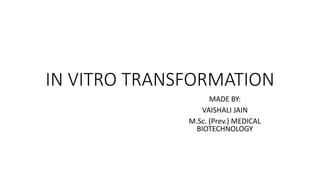
In vitro transformation of cells
- 1. IN VITRO TRANSFORMATION MADE BY: VAISHALI JAIN M.Sc. (Prev.) MEDICAL BIOTECHNOLOGY
- 2. INTRODUCTION • The alteration in a culture that gives rise to a continuous cell line is commonly called in vitro transformation . • Transfection-Artificial introduction of DNA or DNA transfer into mammalian cells • Transformation is associated with genetic instability and three major classes of phenotype change, one or all which may be expressed : • Immortalization – the acquisition of an infinite life span • Aberrant growth control – the loss of contact inhibition of cell motility, density, limitation of cell proliferation and anchorage dependence • Malignancy – Growth of invasive tumors
- 3. • Transformation of cells may occur due to any one of the following causes that ultimately result in a changed genetic material: • i. Spontaneous. • ii. Infection with transforming virus. • iii. From gene transfection. • iv. Exposure to chemical carcinogens. • v. Exposure to ionizing radiations.
- 4. GENETIC INSTABILITY • Human finite cell lines are stable • Mouse cell lines are genetically unstable and transform easily • Continuous cell lines (tumorigenic) of all species are unstable • Two causes of genetic heterogeneity - Spontaneous mutation is higher in vitro - Mutant cells cannot be eliminated without impairment in their growth capacity
- 6. IMMORTALIZATION • Most normal cells have a finite life span of 20 to 100 generations • Rodent cells can produce continuous cell lines with an infinite life span • Rodent cells are karyotypically normal at isolation and undergo changes after 12 th generation • If maintained at a low cell density and not allowed to remain at confluence for any length of time, they remain sensitive to contact inhibition and density limitation of growth • If allowed to remain at confluence for extended periods – reduced contact inhibition- cells pile up – overgrowth- will be seen in subsequent subcultures - tumorigenic
- 8. CONTROL OF SENESCENCE • Senescence genes in finite cells negatively control cell cycle progression • Immortalization involves both inactivation of senescence and cell cycle regulatory genes such as Rb and p53 • Product of SV40 LT gene – T antigen binds to Rb and p53 • Allows extended proliferative life span and restricts DNA surveillance activity of genes - Increases genomic instability - Increases chances of mutations
- 9. • Immortalization – does not imply development of aberrant growth control and malignancy - Retains contact inhibition of cell motility, density limitation of cell proliferation and anchorage dependence and are non-tumorigenic - Some aspects of growth control are abnormal and likely increase of genomic instability
- 10. • Mammalian cells transfected or retrovirally infected with immortalizing gene before they enter senescence • Extends proliferative life span for 20-30 population doublings - Cells cease proliferation and enter crisis - Up to several months in crisis – subset of immortal cells overgrows - Fraction of immortal cells obtained
- 11. Telomerase-Induced Immortalization • Telomerase or terminal transferase – composed of two subunits – RNA component (hTR) and a protein catalytic subunit (hTERT) • hTR is expressed in normal and malignant tissues • hTERT is expressed in tumors, germ cell lines and activated lymphocytes • Transfecting cells with hTERT extends life span of cell line - Some cells become immortal but not malignantly transformed
- 14. ABERRANT GROWTH CONTROL • Cells cultured from tumors ,as well as cultures that have transformed in vitro show aberrations in growth control such as growth to higher saturation densities , clonogenicity in agar and growth on confluent monolayers of homologous cells. • These cell lines exhibit lower serum or growth factor dependence, usually form clones with a higher saturation efficiency and are assumed to have some degree of autonomous growth control by overexpression of oncogenes or by deletion of suppressor genes. • Growth control is often autocrine.
- 15. ANCHORAGE INDEPENDENCE • Transformation due to cell surface modifications in cell surface glycoproteins and adhesion molecules • Fibronectin or large extracellular transformation sensitive (LETS) protein is lost from surface of transformed fibroblasts due to alteration in integrins. This contributes to decrease in cell-cell and cell-substrate adhesions and to decrease requirement for attachment. • Transform cells may lack specific CAMs.
- 16. CONTACT INHIBITION • Detected morphologically by the formation of a disoriented monolayer of cells or rounded cells in foci.
- 17. SERUM DEPENDENCE • Transformed cells have a lower serum dependence due to secretion of autocrine growth factors. • Cause nontransformed cells to adopt transformed phenotype and grow in suspension • Produce interleukins 1,2 and 3 along with colony stimulating factors (CSF) • Hormones released
- 18. Aberrant growth control by Oncogenes • Overexpression of oncogenes • Modified receptors erb-B2 oncogene product, modified G protein and overexpression of genes regulating stages in signal transduction (src kinase) or transcriptional control (myc, fos and jun) • It is permanently active and cannot be easily regulated
- 19. TUMORIGENICITY • Transformation culminates into neoplastic cells • Malignant tumors – increased growth rate, reduced anchorage dependence, more pronounced aneuploidy and immortalization • All cell lineages present within a tumor need not have same transformed properties • Same properties cannot be expressed in every tumor
- 20. Tumorigenicity by malignancy • Cells have developed the capacity to generate invasive tumors if implanted in vivo into an isologous host or if transplanted as a xenograft into an immune-deprived animal.
- 21. INVASIVENESS
- 23. Tumorigenicity by angiogenesis • Tumor cells release factors – VEGF, EGF-2 and angiogenin – capable of neovascularization • Tumor cells produce proteolytic enzymes – plasminogen activator – helps the tumor cells in not attaching to any surface – help them invading other cells